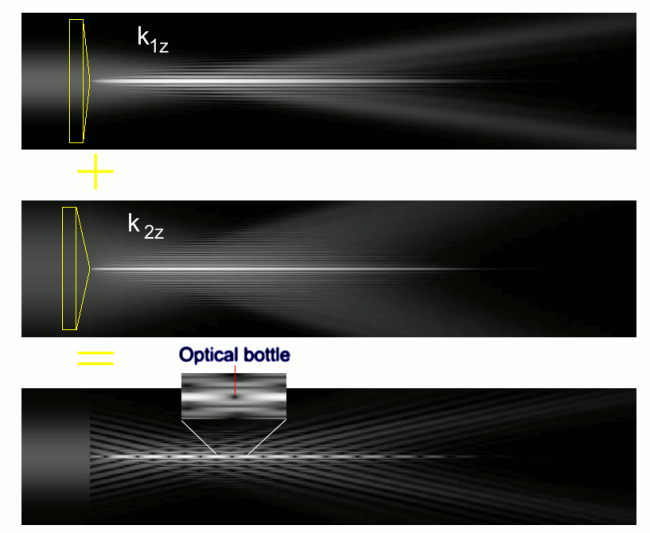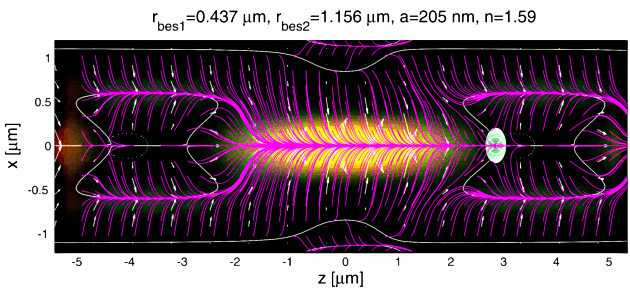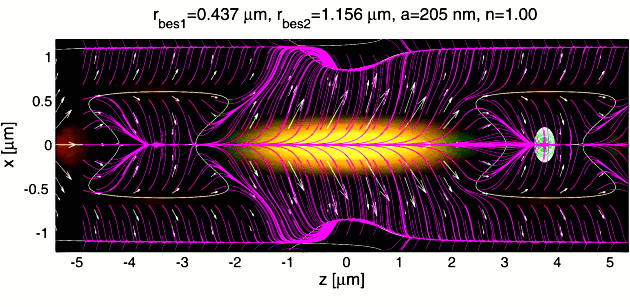Principle of trapping in co-propagating Bessel beams
If two co-propagating beams are coherent, have the same polarization and even different wavelengths, periodic interference structure occurs in spatial optical intensity distribution (it is sometimes called self-imaging). We considered two Bessel beams that had difference axial propagation konstant (axial component of the wavevector) but came from the same laser. They only passed through different axicons.

Would it be possible to trap objects axially to this periodic structure? Will be the intensity gradients strong enough to overcome radiation pressure of two co-propagating beams? Would it be possible to confine objects with refractive index lower than the surrounding medium in the opticle bottle?
We first performed comprehensive theoretical study with experimentaly accessible parametres. We focused first on the axial behaviour of polystyrene beads or air bubles of different sizes. We looked for their equilibrium position, minimal axial depth of the potential well. These results are presented in the form of movies for polystyrene bead and air buble. Green (blue) line corresponds to the axial optical force (potential profile). Crossed circle denotes the object equilibrium position, times shows where is placed the lower edge of the trap (a place where the object escape with higher probability). Particle radius is a, radius of the high intensity core of each beam is rbes1 and rbes2, respectively. dWz is referes about the lowest axial depth of the optical trap.
We also looked for axial trap properties if three and four co-propagating beams are used. Results are shown again in the form of movies for three beams and four beams.
But the particle behaviour is not always determined by the axial trap properties. Therefore we also study the particle trajectories in the field created by two co-propagating Bessel beams. Example of polystyrene bead and air buble is presented below. The pink curves show the particle trajectory from one selected place to the equilibrium position.

Due to the radiation pressure of both beams the polystyrene bead is localized behind the intensity maximum and escape with the highest probability in the axial direction.

However, the air buble sits in the low intensity part of the field where trajetories from much smaller field volume guide the objects. Moreover, for bigger air bubles there is higher probability that these objects do not escape from the trap in axial direction.
T. Cizmar, V. Kollarova, Z. Bouchal, P. Zemanek: "Sub-micron particle organization by self-imaging of non-diffracting beams",
New Journal of Physics 8, 43:1-23, 2006, LINK TO JOURNAL ABSTRACT DOWNLOAD MULTIMEDIA
T. Cizmar, V. Kollarova, M. Siler, P. Jakl, Z. Bouchal, V. Garces-Chavez, K. Dholakia, P. Zemanek: "Non-diffracting beam synthesis used for optical trapping and delivery of sub-micron objects",
Proceedings of SPIE 6195, 619507:1-7, 2006, Nanophotonics, Strasbourg(FR), 3-5 Apr 2006, ABSTRACT DOWNLOAD
Send comments to webmaster
Last modification: 29 Jul 2007

